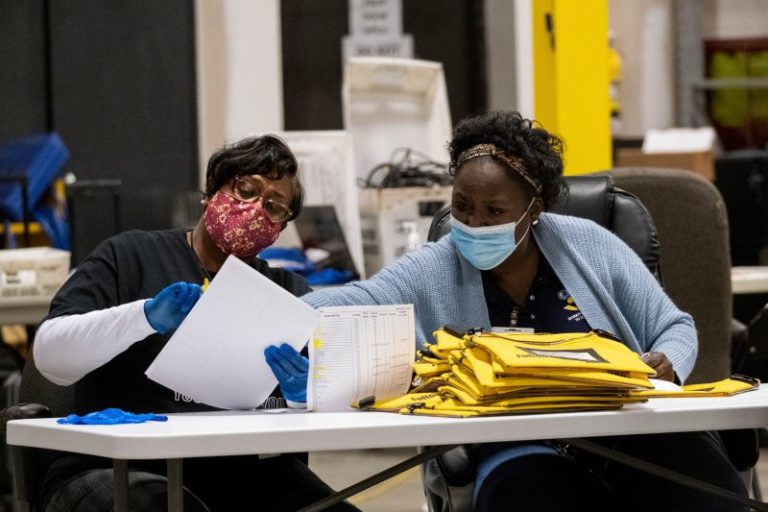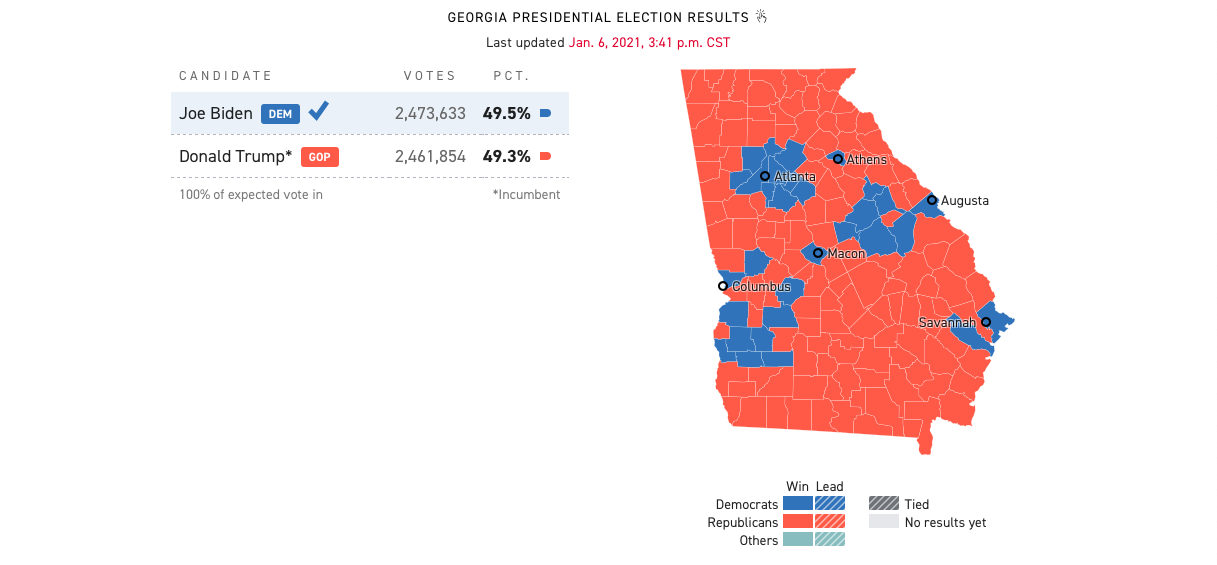Last November I volunteered to serve as an observer in Georgia for a non-governmental organization that specializes in monitoring elections in burgeoning democracies around the world. This was the first time it had agreed to do so in the United States. It is suggestive of the state of elections in our country that we now require election monitoring of a kind more common in Myanmar than in the state of Georgia.
I was assigned to monitor the hand recount in Muscogee County, Columbus, Georgia. Columbus is a small city in Central Georgia across the Chattahoochee River from Alabama. The registered voting population of Muscogee County is about 130,000, of which 81,000 actually cast a ballot in this election. According to the first machine tabulation of the vote, the county went overwhelmingly to President-Elect Joe Biden, by 61% to 37%.
Regardless of the results of the 2020 presidential election, Georgia was due for a hand recount because last year’s elections were the first test of a new hybrid Dominion voting system, consisting of computer scanners and paper ballots. Participants “voted” by touchscreen which then generated a paper ballot that listed the voter’s choices in addition to a machine-readable barcode that was scanned for voter intent. The voter then checked the ballot for accuracy and fed it into a bin that resembled a large garbage can. The ballots were scanned as they were inserted into the ballot box, providing election administrators with a paper trail to verify the machine counted vote.
Originally the State was scheduled to conduct a hand count audit on a random sample of ballots large enough to demonstrate accuracy within a statistically significant range. However, because the election was so close and would most likely require a recount, Georgia Secretary of State Brad Raffensperger decided to replace the audit with a full statewide hand recount.
That decision was announced on Nov. 11, 2020, and was set to start the next day. I was in town for a two-day audit and ended up monitoring the full four-day recount.

In Georgia, the primary responsibility for running elections devolves to the counties. According to guidelines set by the Secretary of State, every ballot had to be seen by two sets of eyes. These “auditors” would have to work without pay, which pushed Muscogee County Supervisor of Elections Nancy Boren to find an interesting solution. She called on Democratic and Republican party representatives from the county to supply the volunteers for the Audit Boards.
There would be one Republican and one Democrat on each Board which turned out to be an inspired decision because it enhanced overall confidence in the result. Only two other counties, out of 159, did the same.
One Democratic auditor told me that her counterpart turned to her at some point and said, “I think I could like you.”
The mail-in ballots were the first to count and they were particularly difficult because voters made a good number of mistakes. Due to the pandemic, there was an unusually large number of mail-in ballots cast. In Georgia, of approximately 5 million votes cast in the 2020 General election, a little more than 1.3 million were absentee.
In a small percentage of absentee ballots, the voter’s intent in voting for president was unclear. There were overvotes (voting for more than one candidate), undervotes (voting for no one), ballots where the marks were unclear, ballots that were torn, ballots with coffee stains, write-in votes for non-qualified candidates (Jesus was a popular choice but he failed to register as a write-in candidate) and someone even sent in an absentee ballot from the primary election.
Even so, the amount of disputed or damaged mail-in ballots were below the 1 percent range of all mail-in ballots. There were almost no disputed machine-generated ballots.
Related Articles: Trump and Mail-In Voting | How Racist is the American Political System?
Putting Democrats and Republicans together to work had an interesting effect. There was very little reason to believe that there was any fraud going on in this particular county and it put party activists in close proximity to one another. One Democratic auditor told me that her counterpart turned to her at some point and said, “I think I could like you.”
When I asked one of the Republican auditors what she thought of the process, she told me that the counting was fair and well organized, but she believed that all they were doing was “counting pieces of paper.” She had no idea where these ballots had come from and whether the voters who cast them were “legal”. Another auditor suspected foul play and wondered how the much larger Fulton County, located at the heart of the Atlanta Metro region, finished counting so quickly.
Doing the math clarifies that question: Fulton County had 172 Audit Boards with 524,000 votes to count while Muscogee County had eight with 81,000 votes to count.
After the mail-in ballots, Muscogee counted the ballots cast on election day. There were only about 13,000 votes on the day of the election, roughly 24,000 mail-in ballots, and 44,000 early voting, in-person ballots. From the observer’s standpoint, it appeared that roughly 60% of the “day of” ballots were Republican, 75% of mail-in ballots were Democratic, with the early votes being close to fifty-fifty but leaning Democratic.
Based on the results of the hand recount, the Secretary of State concluded that the original count was substantially accurate thus establishing the validity of the new machines. Studies have shown that hand recounts can expose an error rate of up to 2%. According to the Secretary of State, the error rate of the Georgia hand recount was .73%. This was with the exception of a number of unreported votes discovered mainly in Floyd County, Rome, Georgia. Floyd County is bedrock Republican and President Trump picked up about 1600 votes from the glitch, far less than he needed to overcome his 14,000-vote deficit.
While it is troubling that there were still disparities in the results this wasn’t due to the machines and it wasn’t the fault of either party — it was the result of human error. Poll workers simply forgot to properly download the results of part of the count.
Even so, when Republicans didn’t get the result they wanted, many turned on Secretary Raffensperger for doing his job. As we all saw, this unsubstantiated belief culminated on January 6, when Trump supporters stormed the U.S. Capitol in order to impede the certification of the results of a free and fair election.
——
Daniel P. Franklin is an Associate Professor (Emeritus), retired from Georgia State University. He is the author of seven books including Pitiful Giants: Presidents in their Final Term.
Editor’s Note: The opinions expressed here by Impakter.com columnists are their own, not those of Impakter.com. — In the Featured Photo: A map shows which cities in the state of Georgia voted for President Donald Trump or President-elect Joe Biden. President-elect Biden won the state by .3% due to Democratic leads in the cities of Augusta, Athens, Atlanta, Columbus, Macon and Savannah. Featured Photo Credit: Politico.











